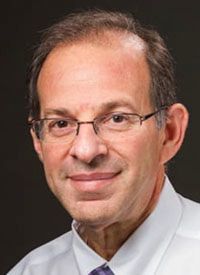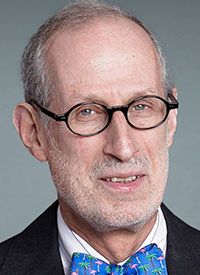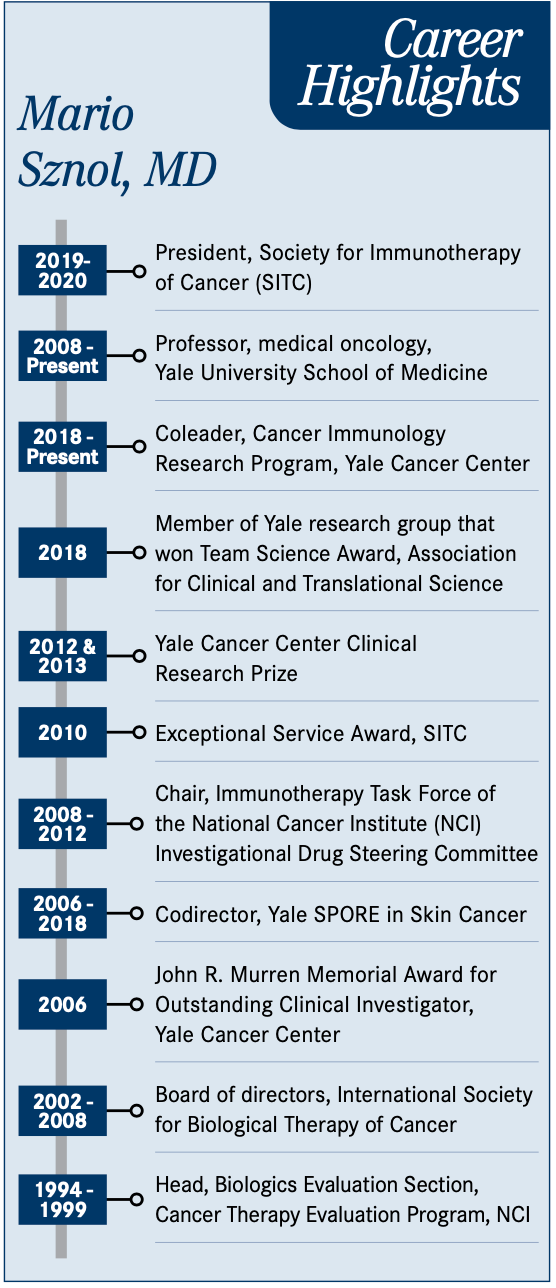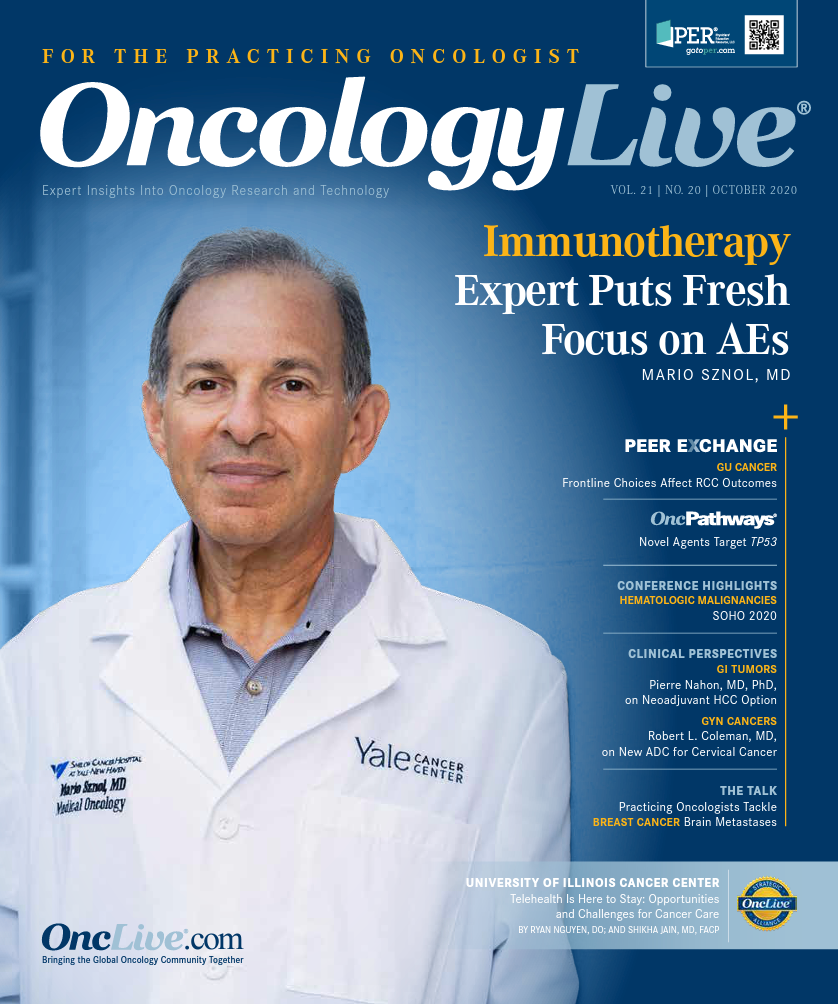Publication
Article
Oncology Live®
Immunotherapy Expert Puts Fresh Focus on AEs
Author(s):
In less than 10 years, immune checkpoint inhibitors (ICIs) have dramatically altered the treatment landscape for patients with metastatic melanoma, helping to drive an improvement in 5-year survival rates from historical levels of less than 10% to more than 50% with some regimens.
Mario Sznol, MD

In less than 10 years, immune checkpoint inhibitors (ICIs) have dramatically altered the treatment landscape for patients with metastatic melanoma, helping to drive an improvement in 5-year survival rates from historical levels of less than 10% to more than 50% with some regimens.1,2
Mario Sznol, MD, was drawn to cancer immunotherapy research from the beginning of his oncology career in the mid-1980s. What he finds most exciting is the way the initial breakthrough in immuno-oncology has expanded to so many other cancer indications, Sznol said in an interview with OncologyLive®. Monoclonal antibodies that target the immune checkpoint protein PD-1, or its main ligand, PD-L1, are now approved in various clinical settings for 18 tumor types plus 2 biomarker-driven indications across solid tumors (Table).3 Additionally, the CTLA-4 immune checkpoint inhibitor ipilimumab (Yervoy) is approved in 6 tumor types.4
However, amid this dizzying pace of advancement, many oncologists struggle to keep up not only with developments but also with how to treat patients suffering from the array of adverse events (AEs) encountered with ICI therapy, said Sznol, professor of medicine (medical oncology) at Yale School of Medicine and coleader of the Cancer Immunology Research Program at Yale Cancer Center, both in New Haven, Connecticut. He also is president of the Society for Immunotherapy of Cancer (SITC).
Importantly, Sznol said, the risk of potentially severe AEs from ICIs or unfamiliarity with their management could influence decisions to offer or receive these agents. “Although toxicity is always an important consideration before offering a therapy, most AEs from ICIs can be managed and reversed, and in most settings, the overall benefit-to-risk ratio is very favorable,” he noted.
In that regard, Sznol has helped make addressing these AEs one of the primary goals of the 5th Annual International Congress on Immunotherapies in Cancer®. The conference, hosted by Physicians’ Education Resource®, LLC (PER®), will be held on December 12, 2020, as a live virtual meeting, with a focus on practice-changing applications. Sznol is cochairing the meeting, along with Naiyer A. Rizvi, MD, the Price Family Professor of Medicine and director of Thoracic Oncology at Columbia University Herbert Comprehensive Cancer Center in New York, New York. Rizvi is also codirector of cancer immunotherapy at Columbia University Irving Medical Center and research director of the Price Family Comprehensive Center for Chest Care at NewYork-Presbyterian Hospital.
As ICIs have become more widely used and incorporated into more combinations, physicians are more likely to encounter some of the rare and unusual AEs, said Sznol, who also is coleader of cancer immunology at Yale Cancer Center.
Dermatologic toxicities are the most frequently reported AE with ICI therapy (all grades, 30%-40% with anti–PD-1/PD-L1 agents; approximately 50% with anti– CTLA-4), particularly rash or pruritus, which has been reported in 13% to 20% of patients who receive the PD-1 inhibitors pembrolizumab (Keytruda) or nivolumab (Opdivo).5 However, although oncologists can generally manage rash without much difficulty, some skin toxicities can be very severe and other common reactions can lead to significant morbidity unless addressed quickly and effectively, Sznol noted. These include colitis, liver function test (LFT) abnormalities, endocrinopathies, nephritis, and pneumonitis. But toxicity can involve any organ system, so it is critical that physicians and all other health care providers involved in patient care have the confidence and skill to administer treatment, Sznol said.
“I expect that fellows who are currently being trained will be used to seeing all these events and for them, managing ICI toxicity will become second nature,” Sznol said. “But health care providers trained in the 1980s or 1990s—and the first of these agents, ipilimumab, was approved only in 2011—may be encountering a set of very unfamiliar AEs. Community oncologists are certainly capable of managing ICI toxicity and in fact manage AEs from other agents, such as chemotherapy, that could lead to even more severe complications, for example, neutropenia. It’s just a matter of developing a different set of reflexes for what to do.”
Sznol said the conference would be a venue for oncologists to learn about ICI toxicities and practical strategies for addressing them. Some of the AEs are so unusual that even physicians in major cancer centers— himself included—find themselves emailing peers across the country to try to find the best treatment option. He said conference organizers have recruited experts who truly understand the use of immunotherapy to provide state-of-the-art information.
“These drugs have been out there for 6 or 7 years, but it’s not surprising that there’s still some uncertainty about how to treat AEs in the clinic, even within very experienced academic centers,” Sznol said. “And perhaps as physicians and their staff are gaining experience, management of some AEs may differ from more established algorithms. The major clinical questions usually revolve around when to start steroids, the initial dose of steroids, when and how to taper the steroids, when to move to a second immunosuppressive agent, or when one can consider restarting ICI treatment after resolution of toxicity.”
Sznol said continuing education is helpful for clinical management of patients whose severe AEs do not respond to initial high-dose steroids and may require a second immuno-suppressive agent, most often for colitis or LFT abnormalities. For colitis, oncologists may not be comfortable with prescribing a tumor necrosis factor inhibitor, generally infliximab (Remicade), or a third-line anti-inflammatory agent, if necessary, such as vedolizumab (Entyvio), or, in the case of LFT elevations, mycophenolate. Continuing education is also helpful in the recognition and initial management of rare ICI-related toxicities such as myositis and myocarditis, as well as neurologic and hematologic events.
Jeffrey S. Weber, MD, PhD

Jeffrey S. Weber, MD, PhD, a 2016 Giants of Cancer Care® award winner who is giving a presentation at the PER® conference about toxicity management that will focus on patient cases, agreed that more education is needed, particularly for emergency room (ER) physicians.
"The classic situation is ER docs who are not used to seeing these patients and don’t think about immune toxicity,” said Weber, deputy director of the Perlmutter Cancer Center and codirector of the melanoma research program at NYU Langone Health in New York, New York. "They’ll think there’s some other cause and not give steroids. The patients will end up going home and coming right back. It’s taking a significant effort with [ED] docs, including giving in-services, just to raise the consciousness of what immune toxicity is about.”
Table. Clinical Settings for FDA-Approved PD-1/PD-L1 Inhibitors3

Weber said an issue that has arisen this year involves ensuring that ER physicians are aware that pneumonitis can be a toxicity associated with immunotherapy. The concern is that physicians will assume the condition is related to coronavirus disease 2019. “The solution is increased education and having a cohort of experts who know the immunotherapy business or a cadre of consultants in endocrinology, [gastroenterology], and [pulmonology] who can see the patients quickly,” he said.
Sznol Helps Define Checkpoint Landscape
The concept of using immunotherapy against cancer was born in 1891 when William B. Coley, MD, a renowned surgeon at Memorial Hospital in New York, used bacteria to successfully treat a New York City man with many inoperable advanced tumors.6
A century later, the field had seen few advances. In 2002, when it came to treat- ing patients with metastatic melanoma, 2 immunotherapeutic options were available: interferon alpha and IL-2. High doses of IL-2 “cured somewhere between 5% and 10% [of patients] with metastatic melanoma,” Sznol said. “And with chemotherapy, we cured almost no one. For chemotherapy, the response rates were in the 15% to 20% range, and [the responses] didn’t last very long.”
It was the excitement around the potential for immunotherapeutic approaches
that changed Sznol’s career path. In the mid-1980s, he was participating in a fellowship at The Mount Sinai Hospital in New York, New York, which was among the few institutions studying IL-2. “That was my very first exposure to immune therapies,” Sznol said. “And the science was really fascinating.”
IL-2 stayed on Sznol’s radar when he took a job at the National Cancer Institute (NCI) in Bethesda, Maryland, in the Cancer Therapy Evaluation Program (CTEP), where he remained for 12 years. His role was to oversee the development of immunotherapy portfolios.
Career Highlights: Mario Sznol, MD
Career Highlights: Mario Sznol, MD

“We got to see everything then— interleukin-2, all the different cytokines that were developed, all kinds of cancer vaccines, and cell therapies,” Sznol said. “We acted like a drug company. One of CTEP’s roles was to develop investigational agents for cancer. So I got a huge amount of exposure to these immunotherapeutic agents. But when I left in ’99, I was not so optimistic about the agents then in development. I left the NCI and went to a biotech company to do something very different although still related to immunotherapy.”
While working at Vion Pharmaceuticals, Sznol and colleagues attempted to target tumors with modified Salmonella, a strategy he initially brought for collaborative study with former colleagues at the NCI.7 They found that in mouse tumor models, the bacteria could replicate preferentially in the tumor microenvironment, and they hoped to be able to deliver cytokines and chemokines there. However, the initial human trials were unable to reproduce the murine results. At that point, Sznol returned to academia, in time for early research into anti–CTLA-4 and anti–PD-1 drugs, which, because of their activity in patients, “just made life much better,” he said. The experiences and the bounty of possibilities helped him envision the future.
“We’ve always been very interested in immunotherapy for cancer, and at Yale I focused on melanoma and renal cancer together with my colleague Harriet Kluger, MD,” Sznol said. “Our center [at Yale] was the first to give the nivolumab-ipilimumab combination to a patient; we conducted the initial part of that phase 1 trial together with Jedd D. Wolchok, MD, PhD, and his colleagues at Memorial Sloan Kettering [MSK] beginning in December 2009. It was a wonderful collaboration between our centers and Medarex/Bristol Myers Squibb, and the results that we saw in that trial were remarkable.”
During a career that has spanned more than 30 years, Sznol has been involved in the development of many immune-modulating therapies, particularly for melanoma and renal cell carcinoma (RCC). Notably, he was among the key investigators in the first multidose phase 1 study of nivolumab (NCT00730639), which demonstrated responses in patients with melanoma, non–small cell lung cancer (NSCLC), and RCC, according to findings reported in the New England Journal of Medicine in 2012.8
In 2013, the results from the first dual ICI therapy with nivolumab and ipilimumab were reported. The combination elicited an objective response rate of 40% (95% CI, 27%-55%) among 52 evaluable patients with unresectable stage III or IV melanoma treated concurrently across all dose levels in the phase 1 CA209-004 trial (NCT01024231).9
Today, the combination of nivolumab plus ipilimumab is approved for unresectable or metastatic melanoma; as first-line treatment for metastatic PD-L1–positive (≥ 1%) NSCLC without EGFR or ALK mutations or in combination with chemotherapy for metastatic or recurrent NSCLC without those mutations; hepatocellular carcinoma (HCC) previously treated with sorafenib (Nexavar); microsatellite instability-high (MSI-H) or mismatch repair–deficient (dMMR) metastatic colorectal cancer progressing after chemotherapy; intermediate- and poor-risk previously treated advanced RCC; and unresectable malignant pleural mesothelioma.10,11
Development of other anti–PD-1 and anti–PD-L1 antibodies and exploration of activity in multiple malignancies followed the initial reports of nivolumab activity in advanced disease. Activity in NSCLC provided proof of concept that these agents could be effective outside melanoma and RCC. In metastatic NSCLC, the estimated 5-year overall survival (OS) rate for patients treated with first-line pembrolizumab monotherapy was nearly twice as high among patients with PD-L1–high (tumor proportion score ≥ 50%) disease as it was for those who received platinum-based chemotherapy, according to updated results from the phase 3 KEYNOTE-024 trial (NCT02142738) presented at the European Society for Medical Oncology Virtual Congress 2020. The OS rate was 31.9% for participants who received pembrolizumab (n = 154) versus 16.3% among those who had chemotherapy (n = 151). The median OS was 26.3 months (95% CI, 18.3-40.4) in the pembrolizumab arm compared with 13.4 months (95% CI, 9.4-18.3) in the chemotherapy group.12
Julie R. Brahmer, MD, who presented the findings at the conference and was among the first investigators to study anti–PD-1 in clinic, is among the speakers at the upcoming PER® meeting. She is codirector of the Upper Aerodigestive Department at the Bloomberg-Kimmel Institute for Cancer Immunotherapy at Johns Hopkins Medicine in Baltimore, Maryland.
Julie R. Brahmer, MD

“I think since the original approval for second-line treatment for metastatic NSCLC [in 2015], we’ve seen an explosion of indications that are making a difference in long-term survival with metastatic disease and now for patients with advanced but unresectable disease after chemotherapy and radiation,” Brahmer said in an interview with OncologyLive®. “We’ve got a long way to go...we just haven’t been out long enough with these checkpoint inhibitors. I think they have changed the face of treating lung cancer.”
Brahmer theorizes that ICIs have made the significant inroads in NSCLC because patients with a history of smoking have a high tumor mutational burden. “When you take the brakes off [with] these checkpoint inhibitors, it allows the immune system to target that kind of cancer,” she said.
ICI Milestones Multiply
The agenda for the December conference reflects broad use of these drugs. The sessions will look at practical applications in clinic for lung cancer, head and neck cancers, genitourinary malignancies, gastrointestinal malignancies, hematologic malignancies, and breast and ovarian cancers.
“Checkpoint inhibitors are used in most solid tumor malignancies with a few exceptions,” Sznol said. “But even in very resistant tumors, such as pancreatic cancer, that could change soon. For example, promising phase 2 data were presented for the combination of chemotherapy, anti-CD40, and nivolumab. Microsatellite-stable colon cancer remains a challenge, but I’m optimistic that continued preclinical and clinical research will eventually lead to an effective immunotherapy option.”
In June 2020, the FDA approved pembrolizumab as a first-line treatment for patients with unresectable or metastatic MSI-H or dMMR colorectal cancer. The announcement marked the first immunotherapy approved for this patient population as a first-line treatment without administering chemotherapy.13
A key development to be discussed at the conference is the FDA’s June 2020 accelerated approval of pembrolizumab for the treatment of adult and pediatric patients with unresectable or metastatic solid malignancies with a high tumor mutational burden (≥ 10 mutations per megabase) whose disease has progressed after prior therapy and who do not have alternative treatment options.14 In 2017, pembrolizumab’s approval for use in advanced solid tumors in patients with the MSI-H/dMMR biomarker marked the first example of a tissue site–agnostic FDA approval of a treatment based on a patient’s tumor biomarker status rather than on histology.15
Many new combinations are coming to the fore with anti–PD1/PD-L1 drugs and VEGFR inhibitors, Sznol noted. In RCC, axitinib (Inlyta), which inhibits VEGFR1/2/3, is approved as first-line treatment for patients with advanced disease in combination with pembrolizumab and with avelumab (Bavencio), a PD-L1 inhibitor, respectively.16
Updated results from the phase 3 KEYNOTE-426 trial (NCT02853331), presented at the 2020 American Society of Clinical Oncology Virtual Scientific Program, demonstrated that median OS was not reached in patients who received the combination of pembrolizumab plus axitinib versus35.7 months among those treated with sunitinib (Sutent), leading to a 32% reduction in the risk of death (HR, 0.68; 95% CI, 0.55- 0.85; P <.001). The 2-year OS rate was 74% and 66% in those who received the combination compared with sunitinib, respectively.17
In the phase 3 JAVELIN Renal 101 trial (NCT02684006), OS findings were still immature but favored the combination of avelumab plus axitinib across prespecified subgroups of patients with previously untreated advanced RCC, according to updated findings reported in Annals of Oncology. In the overall population, the median progression-free survival was 13.3 months (95% CI, 11.1-15.3) with the combination versus 8.0 months (95% CI, 6.7-9.8) with sunitinib, which translated into a 31% reduction in the risk of progression or death (HR, 0.69; 95% CI, 0.574-0.825; 1-sided P < .0001).18
In HCC, the combination of atezolizumab (Tecentriq), an anti–PD-L1 agent, plus bevacizumab (Avastin), a VEGF inhibitor, gained FDA approval in May 2020 for patients who had not previously received systemic therapy, based on findings from the phase 3 IMbrave150 trial (NCT03434379).19 The combination reduced the risk of death by 42% compared with sorafenib (HR, 0.58; 95% CI, 0.42-0.79; P=.0006). OS at 12 months was 67.2% (95% CI, 61.3%-73.1%) with atezolizumab plus bevacizumab and 54.6% (95% CI, 45.2%- 64.0) with sorafenib. Median OS was not estimable (NE) with the combination versus 13.2 months (10.4-NE) with sorafenib.20 Most recently, on July 30, 2020, the FDA approved atezolizumab in combination with 2 targeted therapies, cobimetinib (Cotellic) and vemurafenib (Zelboraf), for patients with BRAF V600-mutant unresectable or metastatic melanoma.21
New Drugs And Biomarkers Top Research Agenda
In terms of research priorities, a need exists for greater insight into which patients are most likely to respond to these therapies, Sznol said. “I think what we’re lacking now is just the predictive biomarkers. It’s really possible that all these combinations are working, but they’re working in small numbers of patients. Without having the biomarkers to identify those patients, the phase 2 combination trials in PD-1/PD-L1 resistant/refractory patients will likely yield low response rates. If we run trials with unselected patients in phase 3, those signals may be too small to detect.”
Although some combination regimens have clearly proved their worth, investigators also do not yet know which drug in a given regimen is most effective or even whether one is effective at all. For example, there is no way to know, as with the nivolumab-ipilimumab combination in previously untreated patients, whether the anti–PD-1 therapy or the anti–CTLA-4 agent—or both—is shrinking the tumor or in what proportion, Sznol said.
To Wolchok, a 2014 Giants of Cancer Care® award winner, Sznol is the perfect individual to help lead the way in improving the efficacy of immunotherapeutic regimens. “We’ve got our work yet cut out for us,” said Wolchok, who is the Lloyd J. Old/Virginia and Daniel K. Ludwig Chair in Clinical Investigation and chief of the Immuno-Oncology Service at MSK in New York, New York. “The next questions we have to answer are: What do [ICIs] need to be combined with? What are the immunologic needs for those not responding to the current therapy?
“I think Mario’s dedication to clinical investigation, to new medicine and new pathways, is critical. Serving as president for SITC—that’s a role he’s really perfect for. He’s a senior statesperson in a field he helped to create,” noted Wolchok, who also is director of the Parker Institute for Cancer Immunotherapy at MSK. “I think having Mario as a leader of that organization really feeds into many of his strengths. He’s a thoughtful clinician, he has great scientific knowledge of the area, he’s very personable, and he’s also a wonderfully supportive voice for colleagues, especially younger colleagues.”
Although Sznol spends 40% to 50% of his time seeing patients in clinic, he and his colleagues at Yale are busy at work on novel therapies. “We’re becoming more and more interested in strategies to modulate antigen-presenting cells and myeloid cells within the tumor microenvironment. So my colleagues have looked at, for example, APX005M, a monoclonal agonist antibody that binds to CD40 together with nivolumab, and more recently APX005M combined with nivolumab and a CSF1 receptor antagonist. Whether that’s going to be the right answer or not, we don’t know,” Sznol said. “We’re about to start a trial of anti-CD40 [therapy] together with anti–PD-1 [and] anti–CTLA-4 in the frontline setting,” he added. “And we’re very excited about that.”
The phase 1 study (NCT04495257) will evaluate APX005M plus nivolumab and ipilimumab in treatment-naïve patients with advanced melanoma or RCC.
Investigators are also looking at how cytokines can combine with ICIs, Sznol said. He and his colleagues were involved with early devel- opment of bempegaldesleukin (Bempeg; NKTR-214), a pegylated form of IL-2.22 The phase 3 PIVOT IO 001 trial (NCT03635983) is evaluating bempegaldesleukin in combination with nivolumab versus nivolumab monotherapy and seeks to enroll 764 patients with previously untreated unresectable or metastatic melanoma.
“There are many different exciting opportunities for combinations,” Sznol said. “But we can participate in only a small fraction of the big world of things that can be done. I don’t know that we have any better information or intuition about what will end up working in resistant/ refractory patients, but [we are] fortunate to be part of an outstanding community of investigators around the world. Hopefully, together we will find effective new immune therapies for patients.”
References:
- NCCN. Clinical Practice Guidelines in Oncology. Cutaneous melanoma, version 4.2020. Accessed September 30, 2020. https://www.nccn.org/professionals/physician_gls/pdf/cutaneous_melanoma.pdf
- Larkin J, Chiarion-Sileni V, Gonzalez R, et al. Five-year survival with combined nivolumab and ipilimumab in advanced melanoma. N Engl J Med. 2019;381(16):1535-1546. doi:10.1056/NEJMoa1910836
- FDA approval timeline of active immunotherapies. Cancer Research Institute. Accessed September 30, 2020. https://bit.ly/30so0lE
- Yervoy. Prescribing information. Bristol Myers Squibb; 2020. Accessed October 1, 2020. https://bit.ly/2SgQHNK
- Puzanov I, Diab A, Abdallah K, et al; Society for Immunotherapy of Cancer Working Group. Managing toxicities associated with immune checkpoint inhibitors: consensus recommendations from the Society for Immunotherapy of Cancer (SITC) Toxicity Management Working Group. J Immunother Cancer. 2017;5(1):95. doi:10.1186/s40425-017-0300-z
- Immunotherapy fact of the day #2. Cancer Research Institute. Accessed September 24, 2020. https://bit.ly/30rd7jT
- Toso JF, Gill VJ, Hwu P, et al. Phase I study of the intravenous administration of attenuated Salmonella typhimurium to patients with metastatic melanoma. J Clin Oncol. 2002;20(1):142-152. doi:10.1200/JCO.2002.20.1.142
- Topalian SL, Hodi FS, Brahmer JR, et al. Safety, activity, and immune correlates of anti–PD-1 antibody in cancer. N Engl J Med. 2012;366(26):2443-2454. doi:10.1056/NEJMoa1200690.
- Wolchok JD, Kluger H, Callhan MK, et al. Nivolumab plus ipilimumab in advanced melanoma. N Engl J Med. 2013;369(2):122-133. Published correction appears in N Engl J Med. 2018; 379(22):2185.
- Opdivo. Prescribing information. Bristol Myers Squibb; 2020. Accessed October 1, 2020. https://bit.ly/3cPmEX3
- Hematology/oncology (cancer) approvals and safety notifications. FDA. Updated September 15, 2020. Accessed September 30, 2020. https://bit.ly/2Sm4mD8
- Brahmer JR, Rodriguez-Abreu D, Robinson AG, et al. KEYNOTE-024 5-year OS update: first-line (1L) pembrolizumab (pembro) vs platinum-based chemotherapy (chemo) in patients (pts) with metastatic NSCLC and PD-L1 tumour proportion score (TPS) ≥50%. Ann Oncol. 2020;31(suppl 4):S1142-S1215. doi:10.1016/annonc/annonc325
- FDA approves first-line immunotherapy for patients with MSI-H/dMMR metastatic colorectal cancer. FDA. June 29, 2020. Accessed September 4, 2020. https://bit.ly/2ESt3UE
- FDA approves pembrolizumab for adults and children with TMB-H solid tumors. FDA. Updated June 17, 2020. Accessed September 4, 2020. https://bit.ly/34e4HNQ
- FDA grants accelerated approval to pembrolizumab for first tissue/site agnostic indication. FDA. Updated May 30, 2017. Accessed October 1, 2020. https://bit.ly/2Sjfm4h
- Inlyta. Prescribing information. Pfizer Inc; 2020. Accessed October 1, 2020. https://bit.ly/3cTBewo
- Plimack ER, Rini BI, Stus V, et al. Pembrolizumab plus axitinib versus sunitinib as first-line therapy for advanced renal cell carcinoma (RCC): updated analysis of KEYNOTE-426. J Clin Oncol. 2020;38(suppl 15):5001. doi:10.1200/JCO.2020.38.15_suppl.5001
- Choueiri TK, Motzer RJ, Rini BI, et al. Updated efficacy results from the JAVELIN Renal 101 trial: first-line avelumab plus axitinib versus sunitinib in patients with advanced renal cell carcinoma. Ann Oncol. 2020;31(8):1030-1039. doi:10.1016/j.annonc.2020.04.010
- FDA approves atezolizumab plus bevacizumab for unresectable hepatocellular carcinoma. FDA. Updated June 1, 2020. Accessed October 1, 2020. https://bit.ly/3lajCQa
- Finn RS, Qin S, Ikeda M et al; IMbrave150 Investigators. Atezolizumab plus bevacizumab in unresectable hepatocellular carcinoma. N Engl J Med. 2020;382(20):1894-1905. doi:10.1056/NEJMoa1915745
- FDA approves atezolizumab for BRAF V600 unresectable or metastatic melanoma. FDA. Updated July 31, 2020. Accessed September 4, 2020. https://bit.ly/3ld8bHr
- Khushalani NI, Diab A, Ascierto PA, et al. Bempegaldesleukin plus nivolumab in untreated, unresectable or metastatic melanoma: phase III PIVOT IO 001 study design. Future Oncol. Published online July 29, 2020. doi:10.2217/fon-2020-0351.






















%20(2)%201-Recovered-Recovered-Recovered-Recovered-Recovered-Recovered-Recovered-Recovered-Recovered-Recovered-Recovered-Recovered-Recovered-Recovered-Recovered-Recovered-Recovered.jpg?fit=crop&auto=format)
%20(2)%201-Recovered-Recovered-Recovered-Recovered-Recovered-Recovered-Recovered-Recovered-Recovered-Recovered-Recovered-Recovered-Recovered-Recovered-Recovered-Recovered-Recovered.jpg?fit=crop&auto=format)
